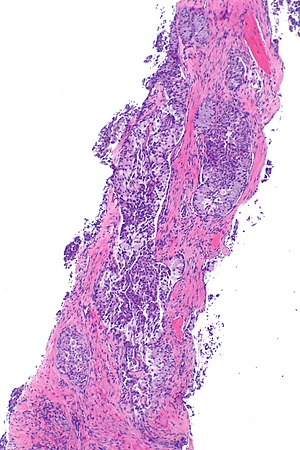EML4-ALK positive lung cancer
| EML4-ALK positive lung cancer | |
|---|---|
 | |
| Micrograph showing ALK positive lung adenocarcinoma. H&E stain. | |
| Specialty | Oncology |
EML4-ALK positive lung cancer is a primary malignant lung tumor whose cells contain a characteristic abnormal configuration of DNA wherein the echinoderm microtubule-associated protein-like 4 (EML4) gene is fused to the anaplastic lymphoma kinase (ALK) gene. This abnormal gene fusion leads to the production of a protein () that appears, in many cases, to promote and maintain the malignant behavior of the cancer cells.[1]
The transforming EML4-ALK fusion gene was first reported in non-small cell lung carcinoma (NSCLC) in 2007.[2]
Signs and symptoms[]
The signs and symptoms of this lung cancer variant seem to mimic those of the underlying major cell type.[citation needed]
Diagnosis[]
Classification[]
Most lung carcinomas containing the EML4-ALK gene fusion are adenocarcinomas.
Some studies suggest that the papillary adenocarcinoma and the [3] variants are more likely to carry this fused gene than other histological variants.
Screening[]

Screening for ALK positive lung cancer is now a standard of care in the United States and Canada. Screening can be done with immunostaining, FISH, or next-generation sequencing (NGS).[citation needed]
Treatment[]
Crizotinib is a targeted therapy (FDA approved in 2011), manufactured by Pfizer and marketed under the brand name Xalkori and Crizalk that targets the EML4/ALK fusion gene.[citation needed]
Ceritinib is a second generation targeted therapy (FDA approved in 2014), manufactured by Novartis and sold under the brand name Zykadia that also targets the EML4 fusion gene, but as a second generation drug it has a smaller molecule that allows superior penetration of the Blood Brain Barrier (BBB) over Crizotinib and is more capable of protecting the Central Nervous System (CNS).[citation needed]
Alectinib another second generation targeted therapy and was approved (for this) by Japan in 2014[4] and by US FDA in 2015.,[5] manufactured by Genentech and marketed under the brand name Alecensa.
Brigatinib a second generation targeted therapy (FDA approved in 2017), manufactured by Takeda and is marketed under the brand name Alunbrig.
Ensartinib is a second generation targeted therapy (trial drug X-396), manufactured by XCovery.[citation needed]
Lorlatinib is a third generation targeted therapy (awaiting FDA approval under trial drug PF-6463922), manufactured by Pfizer.[citation needed]
TPX-0005 is a new third generation targeted therapy drug trial.[citation needed]
Prognosis[]
Treatment with crizotinib achieves 60% response rate.[6] However, crizotinib showed no improvement on overall survival compared to chemotherapy.[7] This may be due to the fact that there was a 70% crossover rate to crizotinib in patients treated initially with chemotherapy.[8] Also, patients who tested negative for EML4/ALK fusion had a response rate to crizotinib of up to 35%.[9]
Epidemiology[]
EML4-ALK gene fusions occur almost exclusively in carcinomas arising in non-smokers.[10][11] About 4% of non-small-cell lung carcinomas involve an EML4-ALK tyrosine kinase fusion gene.[12] 4–6% of lung adenocarcinomas involve the fusion gene.[6]
EML4-ALK mutation rarely occurs in combination with K-RAS or EGFR mutations.
References[]
- ^ Soda M, Choi YL, Enomoto M, et al. (August 2007). "Identification of the transforming EML4-ALK fusion gene in non-small-cell lung cancer". Nature. 448 (7153): 561–6. Bibcode:2007Natur.448..561S. doi:10.1038/nature05945. PMID 17625570. S2CID 2172543.
- ^ Sasaki T, Rodig SJ, Chirieac LR, Jänne PA (July 2010). "The biology and treatment of EML4-ALK non-small cell lung cancer". Eur. J. Cancer. 46 (10): 1773–80. doi:10.1016/j.ejca.2010.04.002. PMC 2888755. PMID 20418096.
- ^ Koh Y, Kim DW, Kim TM, et al. (May 2011). "Clinicopathologic characteristics and outcomes of patients with anaplastic lymphoma kinase-positive advanced pulmonary adenocarcinoma: suggestion for an effective screening strategy for these tumors". J Thorac Oncol. 6 (5): 905–12. doi:10.1097/JTO.0b013e3182111461. PMID 21358343. S2CID 38377715.
- ^ Japan becomes first country to approve Roche’s alectinib for people with a specific form of advanced lung cancer
- ^ New Oral Therapy To Treat ALK-Positive Lung Cancer. Dec 2015
- ^ Jump up to: a b Bayliss, R; Choi, J (March 2016). "Molecular mechanisms that underpin EML4-ALK driven cancers and their response to targeted drugs". Cellular and Molecular Life Sciences. 73 (6): 1209–1224. doi:10.1007/s00018-015-2117-6. PMC 4761370. PMID 26755435.
- ^ https://www.accessdata.fda.gov/drugsatfda_docs/label/2017/202570s019lbl.pdf
- ^ Solomon, Benjamin J.; Mok, Tony; Kim, Dong-Wan; Wu, Yi-Long; Nakagawa, Kazuhiko; Mekhail, Tarek; Felip, Enriqueta; Cappuzzo, Federico; Paolini, Jolanda; Usari, Tiziana; Iyer, Shrividya; Reisman, Arlene; Wilner, Keith D.; Tursi, Jennifer; Blackhall, Fiona; PROFILE 1014 Investigators (2014). "First-Line Crizotinib versus Chemotherapy in ALK-Positive Lung Cancer". New England Journal of Medicine. 371 (23): 2167–2177. doi:10.1056/NEJMoa1408440. hdl:2434/426878. PMID 25470694.
- ^ https://www.accessdata.fda.gov/cdrh_docs/pdf11/P110012B.pdf
- ^ Shaw AT, Yeap BY, Mino-Kenudson M, et al. (September 2009). "Clinical Features and Outcome of Patients With Non–Small-Cell Lung Cancer Who Harbor EML4-ALK". Journal of Clinical Oncology. 27 (26): 4247–4253. doi:10.1200/JCO.2009.22.6993. PMC 2744268. PMID 19667264.
- ^ Martelli MP, Sozzi G, Hernandez L, et al. (February 2009). "EML4-ALK rearrangement in non-small cell lung cancer and non-tumor lung tissues". Am. J. Pathol. 174 (2): 661–70. doi:10.2353/ajpath.2009.080755. PMC 2630573. PMID 19147828.
- ^ Kumar, V; Abbas AK; Aster JC (2013). "Chapter 5". Robbins Basic Pathology (9th ed.). Elsevier Saunders. p. 212. ISBN 978-1-4377-1781-5.
External links[]
- Lung cancer